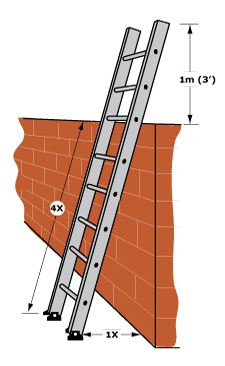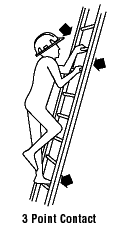Ladders - Portable
On this page
- What are portable ladders?
- What should you know about portable ladders before using them?
- What should you do before using a portable ladder?
- What should you avoid when using a portable ladder?
- How should you set up the ladder?
- What should you know about climbing portable ladders?
- What should you avoid when climbing portable ladders?
What are portable ladders?
Back to topA portable ladder is a ladder that can be easily moved or carried. Portable ladders are available in various grades: light duty or grade 3; medium duty or grade 2; heavy duty or grade 1.
What should you know about portable ladders before using them?
Back to topFalls from portable ladders are a major source of serious injury. Be aware of the hazards and take proper precautions to prevent falling.
Incidents involving ladders are usually caused by:
- Using the wrong ladder for the specific job.
- Using ladders that are defective or in poor condition.
- Improper care or use, including incorrect positioning, not securing the ladder properly, placing on poor footing, etc.
- Workers not being trained adequately to maintain, use or work from ladders safely.
What should you do before using a portable ladder?
Back to top- Use a ladder designed for your task. Consider the strength, type, length and the Canadian Standards Association (CSA) approval.
- Read and follow all the labels and markings on the ladder.
- Make sure the load rating is indicated on the ladder and is appropriate for the user, equipment, and task.
- Inspect the ladder before and after each use.
- Reject and tag any ladders that have defects. Have faulty ladders repaired or thrown out.
- Get help when handling a heavy or long ladder.
- Keep ladders away from power wires, and if electricity is a hazard, a fibreglass ladder should be used.
- Tie off extensions or straight ladders at the top and secure bottom to prevent them from slipping.
- Set up barricades and warning signs when using a ladder in a doorway or passageway.
- Before mounting a ladder, clean the boot soles if they are muddy or slippery. Avoid climbing with wet soles. Ensure that footwear is in good condition.
- Face the ladder when going up or down and when working from it.
- Keep the centre of your body within the middle of the side rails.
- Consider having another worker hold and support the base of the ladder when needed
Refer to safety regulations for specific measurement requirements. Refer to the CSA Z11-18 (R2022) Portable Ladders standard or the most current version for more requirements.
What should you avoid when using a portable ladder?
Back to top- Do not use a ladder in a horizontal position as a scaffold plank or runway.
- Do not carry objects in your hands while on a ladder. Hoist materials or attach tools to a belt.
- Do not work from the top three rungs. The higher a person goes on a ladder, the greater the possibility that the ladder will slip out at the base.
- Do not use items such as a chair, barrel or box as a makeshift ladder.
- Do not use a portable ladder when other types of equipment and safe means of access are available. Replace a ladder with a fixed stairway or scaffold.
- Do not join two short ladders to make a longer ladder. Side rails are not strong enough to support the extra load.
- Do not paint wooden ladders. The paint may hide defects. Wood preservatives or clear coatings may be used.
How should you set up the ladder?
Back to top- Make sure to set up the ladder at the required angle, using the 4-to-1 Rule: For every 4 feet (1.2 metres) up, place the base of your ladder 1 foot (0.3 metres) from the wall or upper support it rests against. This placement will set up the ladder with a pitch of 75 degrees, creating the ideal angle for climber balance, ladder strength, and helps prevent the ladder from slipping.
- Make sure always to follow the instructions provided by the manufacturer.

- Extend the ladder at least 1 m (3 ft) above the landing platform or the point of support.
- Place the ladder on a firm, level footing. Use a ladder with slip-resistant feet or secure blocking. Brace or tie the bottom of the ladder.
- Rest both side rails on the top support and secure the ladder to prevent slipping.
What should you know about climbing portable ladders?
Back to top- Check for overhead power lines and other hazards before setting up a ladder.
- Clear the area around the base and top of the ladder of debris, tools and other objects.
- Wear a safety harness and tie the lanyard off to a proper anchor (e.g., designed fixed support, temporary fixed support, or existing structural feature or equipment) when working 3 m (10 ft) or more off the ground or when working with both hands. Make sure that you have been trained on how to use fall protection devices safely.
- Ensure that only one person is on a single-width ladder. Only one person is allowed on each side of a double-width ladder.
- Maintain three-point contact by keeping two hands and one foot or two feet and one hand on the ladder at all times.
- Grasp the rungs when climbing a ladder, not the side rails. If your foot slips on a ladder, holding onto rungs is easier than holding onto the side rails.

- Wear protective footwear with slip-resistant soles and heels.
- Ensure that all electrical equipment used during ladder work is in good condition and properly grounded.
- Rest frequently to avoid arm fatigue and disorientation when the work requires you to look up and reach above your head.
- Drape your arms over a rung and rest your head against another rung or side rail if you become dizzy or panicky. Climb down slowly.
What should you avoid when climbing portable ladders?
Back to top- Do not use ladders when a safe means of access is available and practical.
- Do not use a ladder in passageways, doorways, driveways, or other locations where a person or vehicle can hit it. Set up suitable barricades or lock the doors shut.
- Do not place a ladder against flexible or moveable surfaces.
- Do not straddle the space between a ladder and another object.
- Do not erect ladders on boxes, carts, tables, scaffolds, or other unstable surfaces.
- Do not use ladders on ice, mud, or other slippery surfaces.
- Do not stand a ladder on any of its rungs. Ladders must rest on both side rails.
- Do not allow anyone to stand under a ladder.
- Do not support ladders on their rungs.
- Do not overreach from a ladder; move as required.
- Do not use any type of ladder near overhead power lines unless the safe distance is maintained. Check with your local jurisdiction as this distance may be regulated in your area.


- Fact sheet last revised: 2023-07-31

